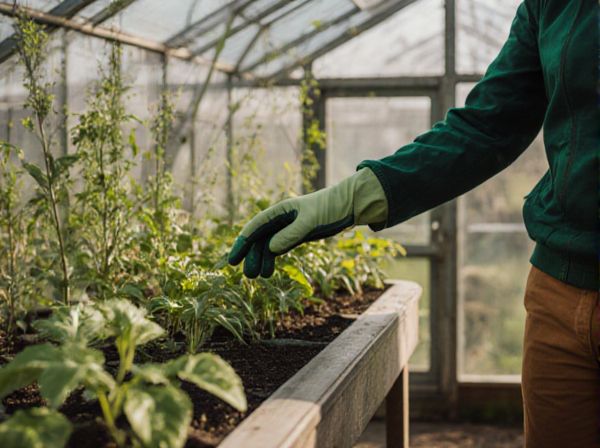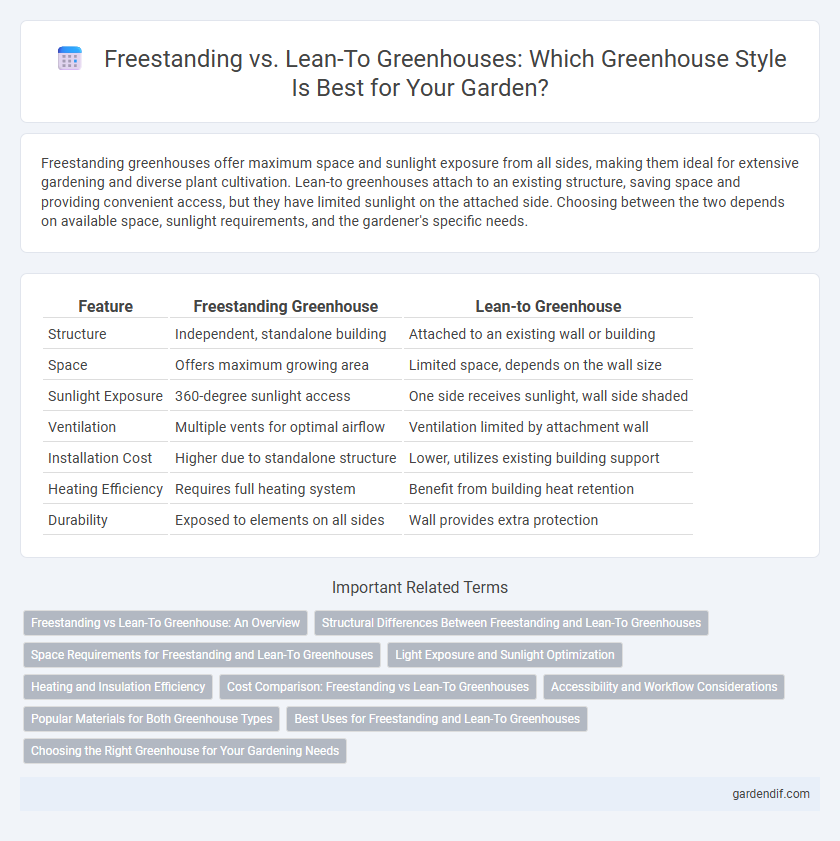
Freestanding greenhouse vs lean-to greenhouse Illustration
Freestanding greenhouses offer maximum space and sunlight exposure from all sides, making them ideal for extensive gardening and diverse plant cultivation. Lean-to greenhouses attach to an existing structure, saving space and providing convenient access, but they have limited sunlight on the attached side. Choosing between the two depends on available space, sunlight requirements, and the gardener's specific needs.
Table of Comparison
| Feature | Freestanding Greenhouse | Lean-to Greenhouse |
|---|---|---|
| Structure | Independent, standalone building | Attached to an existing wall or building |
| Space | Offers maximum growing area | Limited space, depends on the wall size |
| Sunlight Exposure | 360-degree sunlight access | One side receives sunlight, wall side shaded |
| Ventilation | Multiple vents for optimal airflow | Ventilation limited by attachment wall |
| Installation Cost | Higher due to standalone structure | Lower, utilizes existing building support |
| Heating Efficiency | Requires full heating system | Benefit from building heat retention |
| Durability | Exposed to elements on all sides | Wall provides extra protection |
Freestanding vs Lean-To Greenhouse: An Overview
Freestanding greenhouses offer 100% exposure to sunlight with independent structures ideal for large-scale gardening or research, while lean-to greenhouses attach to existing buildings, utilizing shared walls to conserve space and heat. Freestanding models provide superior air circulation and design flexibility, whereas lean-to designs benefit from reduced construction costs and easier temperature regulation through proximity to the main structure. Choosing between freestanding and lean-to greenhouses depends on available space, budget, and specific gardening needs.
Structural Differences Between Freestanding and Lean-To Greenhouses
Freestanding greenhouses are independent structures with four walls and equal exposure to sunlight, allowing for maximum space and ventilation flexibility. Lean-to greenhouses attach directly to an existing building, sharing one wall that provides structural support and reduces construction costs but limits light exposure and airflow on that side. These structural differences impact plant growth potential, environmental control, and spatial requirements within each greenhouse type.
Space Requirements for Freestanding and Lean-To Greenhouses
Freestanding greenhouses require significantly more space, typically positioned in open areas with room for access and ventilation on all sides, ideal for gardens with ample yard area. Lean-to greenhouses attach to existing structures, saving space by utilizing a wall for support, making them perfect for small gardens or urban settings with limited outdoor space. Understanding these spatial demands helps optimize greenhouse placement for maximizing plant growth and ease of maintenance.
Light Exposure and Sunlight Optimization
Freestanding greenhouses offer 360-degree sunlight exposure, maximizing natural light absorption for all plant types throughout the day. Lean-to greenhouses rely on an existing wall, which limits sunlight to three sides but benefits from reflected heat and light, enhancing energy efficiency. Optimal sunlight optimization depends on location and orientation, with freestanding structures suited for open spaces and lean-to designs ideal near south-facing walls in northern hemispheres.
Heating and Insulation Efficiency
Freestanding greenhouses offer superior heating and insulation efficiency due to their ability to retain heat evenly from all sides, minimizing energy loss through walls. Lean-to greenhouses, attached to existing buildings, benefit from shared wall insulation that reduces heat loss but may suffer from uneven temperature distribution. Optimizing insulation materials and using thermal mass storage can enhance heating efficiency in both greenhouse types.
Cost Comparison: Freestanding vs Lean-To Greenhouses
Freestanding greenhouses generally have higher initial costs due to their larger size and the need for a full support structure, while lean-to greenhouses are more cost-effective as they utilize an existing wall for support, reducing materials and construction expenses. Maintenance and energy costs for freestanding greenhouses can be higher because they are exposed on all sides, requiring more heating and cooling, whereas lean-to designs benefit from shared insulation with the attached building. For budget-conscious gardeners, lean-to greenhouses offer significant savings in both setup and operational costs without compromising growing space efficiency.
Accessibility and Workflow Considerations
Freestanding greenhouses offer 360-degree accessibility, allowing gardeners to easily move around and organize plants for optimal workflow. Lean-to greenhouses, attached to existing structures, provide limited access on three sides but benefit from shared resources like water and electricity. Choosing between the two depends on space availability and the need for unobstructed movement during planting and maintenance tasks.
Popular Materials for Both Greenhouse Types
Freestanding greenhouses and lean-to greenhouses commonly utilize materials such as aluminum, galvanized steel, and wood for their frames, each offering varying durability and aesthetic appeal. Polycarbonate panels and tempered glass are popular glazing options, providing excellent light transmission and insulation for plant growth. The choice between these materials influences the greenhouse's thermal efficiency, maintenance needs, and overall lifespan.
Best Uses for Freestanding and Lean-To Greenhouses
Freestanding greenhouses are ideal for gardeners seeking maximum space and sunlight exposure, allowing for diverse plant cultivation and optimal air circulation. Lean-to greenhouses are best suited for small spaces or urban settings, attaching to existing structures to utilize shared heating and reduce construction costs. Both types support year-round growing but cater to different spatial and structural needs based on site conditions and gardening goals.
Choosing the Right Greenhouse for Your Gardening Needs
Freestanding greenhouses provide maximum space and light exposure, ideal for extensive gardening projects and growing a wide variety of plants. Lean-to greenhouses utilize existing walls for support, optimizing space and warmth by sharing heat with the adjoining structure, perfect for small gardens or limited outdoor areas. Selecting between freestanding and lean-to greenhouses depends on available space, climate control requirements, and the scale of gardening activities desired.
Freestanding greenhouse vs lean-to greenhouse Infographic

 gardendif.com
gardendif.com